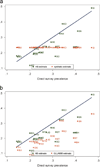Self-rated health: small area large area comparisons amongst older adults at the state, district and sub-district level in India
- PMID: 24361576
- PMCID: PMC3944101
- DOI: 10.1016/j.healthplace.2013.12.002
Self-rated health: small area large area comparisons amongst older adults at the state, district and sub-district level in India
Abstract
We compared prevalence estimates of self-rated health (SRH) derived indirectly using four different small area estimation methods for the Vadu (small) area from the national Study on Global AGEing (SAGE) survey with estimates derived directly from the Vadu SAGE survey. The indirect synthetic estimate for Vadu was 24% whereas the model based estimates were 45.6% and 45.7% with smaller prediction errors and comparable to the direct survey estimate of 50%. The model based techniques were better suited to estimate the prevalence of SRH than the indirect synthetic method. We conclude that a simplified mixed effects regression model can produce valid small area estimates of SRH.
Keywords: Empirical best linear unbiased prediction; Hierarchical Bayes estimation; Self-rated health; Small area estimation.
© 2013 Published by Elsevier Ltd.
Figures



Similar articles
-
'In general, how do you feel today?'--self-rated health in the context of aging in India.Glob Health Action. 2014 Apr 22;7:23421. doi: 10.3402/gha.v7.23421. eCollection 2014. Glob Health Action. 2014. PMID: 24762983 Free PMC article.
-
Does self-rated health predict death in adults aged 50 years and above in India? Evidence from a rural population under health and demographic surveillance.Int J Epidemiol. 2012 Dec;41(6):1719-27; author reply 1727-8. doi: 10.1093/ije/dys163. Epub 2012 Nov 21. Int J Epidemiol. 2012. PMID: 23175517 Free PMC article.
-
Navigating trust and health in India: the influence of social status and neighbourhood environment.BMC Public Health. 2024 Oct 1;24(1):2680. doi: 10.1186/s12889-024-19826-7. BMC Public Health. 2024. PMID: 39354452 Free PMC article.
-
Self-rated health among older adults in India: Gender specific findings from National Sample Survey.PLoS One. 2023 Apr 17;18(4):e0284321. doi: 10.1371/journal.pone.0284321. eCollection 2023. PLoS One. 2023. PMID: 37068072 Free PMC article.
-
[Potentials in the regionalization of health indicators using small-area estimation methods : Exemplary results based on the 2009, 2010 and 2012 GEDA studies].Bundesgesundheitsblatt Gesundheitsforschung Gesundheitsschutz. 2017 Dec;60(12):1429-1439. doi: 10.1007/s00103-017-2649-z. Bundesgesundheitsblatt Gesundheitsforschung Gesundheitsschutz. 2017. PMID: 29067498 Review. German.
Cited by
-
Province-Level Prevalence of Psychiatric Disorders: Application of Small-Area Methodology to the Iranian Mental Health Survey (IranMHS).Iran J Psychiatry. 2019 Jan;14(1):16-32. Iran J Psychiatry. 2019. PMID: 31114614 Free PMC article.
References
-
- Amoako Johnson F, Chandra H, Brown JJ, Padmadas SS. District-level estimates of Institutional Births in Ghana: application of small area estimation technique using census and DHS data. J. Off. Stat. 2010;26:341–359.
-
- Amoako Johnson F, Padmadas SS, Chandra H, Matthews Z, Madise NJ. Estimating unmet need for contraception by district within Ghana: an application of small-area estimation techniques. Popul. Stud. (Camb) 2012;66:105–122. - PubMed
-
- Asiimwe JB, Jehopio P, Atuhaire LK, Mbonye AK. Examining small area estimation techniques for public health intervention: lessons from application to under-5 mortality data in Uganda. J. Public Health Policy. 2011 2010/12/15 ed. - PubMed
-
- Bajekal M, Scholes S, Pickering K, Purdon S. National Center for Social Research. Department of Health., UK; 2004. Synthetic Estimation of Healthy Lifestyles Indicators: Stage 1 Report; pp. 3–35.
-
- Banks J, Marmot M, Oldfield Z, Smith JP. The SES health gradient on both sides of the Atlantic. In: Wise DA, editor. Developments in the Economics of Aging. Chicago: University of Chicago Press; 2007. pp. 359–406.
Publication types
MeSH terms
Grants and funding
LinkOut - more resources
Full Text Sources
Other Literature Sources

